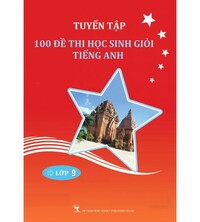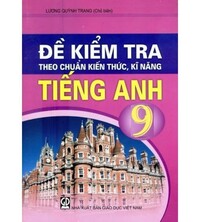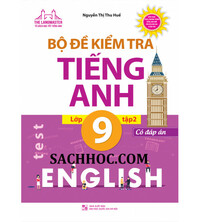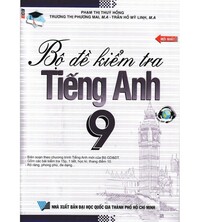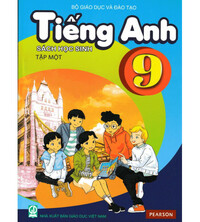Reading - trang 37 - Unit 10 - SBT tiếng Anh 9 mới
Read the following NASA fact sheet about the Hubble Space Telescope and do the tasks. Đọc các thông tin sau về tàu thám hiểm Hubble Space của NASA và làm bài tập.
Bài 1
Task 1. Read the following NASA fact sheet about the Hubble Space Telescope and do the tasks.
Đọc các thông tin sau về tàu thám hiểm Hubble Space của NASA và làm bài tập.
A named after Edwin P. Hubble, who discovered that the Milky Way was only one of many galaxies
B launched into space on April 24,1990
C orbits about 547 kilometres above Earth
D is the length of a large school bus, and weighs as much as two adult elephants
E travels about 8 kilometres per second
F is solar-powered
G takes sharp pictures of objects in space such as planets, stars, and galaxies for research
H has made more than one million observations
a, Put the facts under the appropriate headings. More than one fact can go with one heading.
Xếp các thông tin sau vào đúng tiêu đề. Một thông tin có thể nằm trong hai tiêu đề.
1. Size and weight
2. Name
3. History
4. Mission
5. Position and speed
6. Power source
Key - Đáp án:
1. D 2. A 3.B 4G.H 5. C, E 6. F
b, Decide if the following statements are true (T) or false (F).
Các câu sau đúng hay sai.
1. The Hubble Space Telescope is named after the scientist who created it.
Đáp án: F (It is namec scientist who discovered that the Milky Way is just one galaxy among
others.)
Tạm dịch: Kính viễn vọng Không gian Hubble được đặt tên theo nhà khoa học đã tạo ra Kính viễn vọng Không gian Hubble.
2. The telescope moves in space around the Earth.
Đáp án: T
Tạm dịch: Kính thiên văn di chuyển trong không gian xung quanh trái đất.
3. It is as heavy as one elephant.
Đáp án: F (It is as heav. is .-.e of two adult elephants.)
Tạm dịch: Nó nặng bằng một con voi.
4. Its speed is about 480 kilometres per minute.
Đáp án: T
Tạm dịch: Tốc độ của nó khoảng 480 km/phút.
5. The telescope uses wind energy for its operation.
Đáp án: F (It is powered by solar energy)
Tạm dịch: Kính thiên văn sử dụng năng lượng gió để vận hành.
6. Its mission is to take pictures of the universe for scientific reseat.
Đáp án: T
Tạm dịch: Nhiệm vụ của nó là chụp ảnh vũ trụ để nghiên cứu khoa học.
Bài 2
Task 2. Read the text and choose the best answers.
Đọc đoạn văn sau và chọn đáp án đúng.
Earth, our beautiful home planet, is the only astronomica object to accomodate life as we know it. Scientists believe Earth was formed approximately 4.5 billion years ago. It is the fifth-largest planet in our solar system. Its equatorial diameter is about the third-closest planet to the sun. The distance from Earth to the sun is roughly 149,600,000 kometres. It takes 365.3 days for Earth to orbit the sun, and 24 hours to rotate on its axis. The surface temperature ranges from -88 to 58C. Nearty 70 percent of Earth's surface is covered by ocean, which has an average depth of about 4 kilometres. In 2015 it was estimated that 7.3 billion humans are living on Earth.
Tạm dịch:
Trái đất, mái nhà tuyệt đẹp của chúng ta, là vật thể thiên văn duy nhất có thể chứa đựng cuộc sống như chúng ta đã biết. Các nhà khoa học tin rằng trái đất đã được hình thành khoảng 4,5 tỷ năm trước. Đây là hành tinh lớn thứ năm trong hệ mặt trời của chúng ta. Đường kính xích đạo của nó là khoảng hành tinh gần nhất thứ ba tới mặt trời. Khoảng cách từ trái đất đến mặt trời là khoảng 149.600.000 km. Phải mất 365,3 ngày để Trái Đất quay vòng mặt trời, và 24 giờ để quay trên trục của nó. Nhiệt độ bề mặt dao động từ -88 đến 58C. Gần 70 phần trăm bề mặt trái đất được bao phủ bởi đại dương, có độ sâu trung bình khoảng 4 km. Vào năm 2015 ước tính có 7,3 tỷ người đang sống trên trái đất.
1. As we know it, Earth is the only planet that accommodates life. It is______.
A. habitable B. habitual C. habitat
Tạm dịch:
habitable (adj): có thể ở được
habitual (adj): thương lệ, thường xuyên
habitat (n): môi trường sống
Giải thích: dựa vào câu ở trước, ta có thể đoán được đại ý câu sau là: trái đất là hành tinh duy nhất có thể ở được nên ta chọn "habitable"
2. There are _____________ planets between Earth and the sun.
A. two B. three C. four
Giải thích:dựa vào câu: Its equatorial diameter is about the third-closest planet to the sun (Đường kính xích đạo của nó là khoảng hành tinh gần nhất thứ ba tới mặt trời) nên ta đoán được rằng giữa mặt trời và trái đất có 2 hành tinh hoặc dựa vào hiểu biết cá nhân giữa mặt trời và trái đất có Sao thủy và Sao kim
3. In our solar system,______ planets are larger than Earth.
A two B. three C. four
Giải thích: dựa vào câu: Earth is the fifth-largest planet in our solar system ta biết được rằng có 4 hành tinh lớn hơn Trái Đất
4. The hottest place on Earth may have the temperature of____ .
A -88°C B. 58°C C. 40°C
Giải thích:dựa vào câu: The surface temperature ranges from -88 to 58C (Nhiệt độ bề mặt dao động từ -88 đến 58C)
5. It takes_______ for Earth to rotate on its axis.
A. one year B. one month C. one day
Giải thích: dựa vào câu: It takes 365.3 days for Earth to orbit the sun, and 24 hours to rotate on its axis (Phải mất 365,3 ngày để Trái Đất quay vòng mặt trời, và 24 giờ để quay trên trục của nó)
6. Most of Earth's surface is covered by_____.
A. ocean B. mountain C. forest
Giải thích: dựa vào câu: Nearty 70 percent of Earth's surface is covered by ocean, which has an average depth of about 4 kilometres. (Gần 70 phần trăm bề mặt trái đất được bao phủ bởi đại dương, có độ sâu trung bình khoảng 4 km)
Bài 3
Task 3. Read the text and do the activities that follow.
Đọc đoạn văn sau và làm bài tập.
Did you knowthatthe spacesuit astronauts wear while in outer space is formally called ar Extravehicular Mobility Unit, or EMU? ‘Extravehicular’ means outside of a spacecraft, and (1) ‘______________ ’ means that the astronaut can move around in the suit, independent of the (2)_____. An EMU is not simply a set of clothes. The suit provides life upport and environmental protection for the astronaut during planetary exploration or (3)___. For example, spacesuits protect astronauts from extreme temperature change, which can go as cold as (4)__ _________ , or as hot as 120 degrees Celsius Spacesuits also supply astronauts with (5) __________ to breathe and water to drink during spacewalks. They protect astronauts against fast-moving space dust particles, (6) ____, and bright sunlight.
a, Put the following words/phrases in the appropriate gaps in the text.
Xếp các từ/cụm từ sau vào đúng vị trí trong đoạn văn.
spacewalks oxygen
radiation spacecraft
mobility minus 150 degrees Celsius
Key - Đáp án:
1. mobility
2. spacecraft
3. spacewalks
4. minus 150 degrees Celsius
5. oxygen
6. radiation
b, Answer the questions.
Trả lời các câu hỏi sau.
1. What does EMU stand for?
2. Why is an EMU spacesuit more than a set of dothes?
3. When do astronauts wear an EMU?
4. Give one example of how an EMU provides astronauts with enviromental protection.
5. Give one example of how an EMU provides life support for astronauts.
Key - Đáp án:
1. EMU stands for Extravehicular Mobility Unit.
Tạm dịch: EMU là viết tắt của Unit Mobility Extravehicular.
2. An EMU provides astronauts with mobility, life support, and environmental protection.
Tạm dịch: EMU cung cấp cho các phi hành gia khả năng di chuyển, hỗ trợ sự sống và bảo vệ môi trường.
3. When they are in space doing spacewalks or during planetary exploration.
Tạm dịch: Khi họ đang ở trong không gian hoặc trong khám phá hành tinh.
4. It protects astronauts from extreme temperatures/radiation/space dust particles.
Tạm dịch: Nó bảo vệ các phi hành gia khỏi nhiệt độ cực/bức xạ/không gian chứa các phân tử hạt bụi.
5. It supplies astronauts with oxygen/water.
Tạm dịch: Nó cung cấp cho phi hành gia khí oxy/nước.
Search google: "từ khóa + timdapan.com" Ví dụ: "Reading - trang 37 - Unit 10 - SBT tiếng Anh 9 mới timdapan.com"
